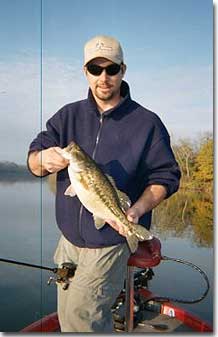The Alabama Spotted Bass
The Alabama Spotted Bass
By Reed Montgomery
Thousands of Alabama anglers seek the ever-popular largemouth bass as their primary target on weekend outings, although many affirm that catching a spotted bass is second to none. Both species co-exist in many of Alabama's Lakes and rivers, explaining why some anglers catch an occasional "spot" while fishing for largemouth bass. Spotted bass are well known for their aggressiveness. Once hooked, an angler is fortunate to land one. There are many distinct and very easily identifiable differences that exist between these two bass species.  Spotted bass prefer cooler water, thus making them unfit for life in farm ponds where midsummer surface water temperatures can reach the 90-degree mark. They also favor areas low in turbidity, which excludes sites that receive excessive runoff from tilled agricultural regions. In impoundments where the two species co-exist, spotted bass tend to inhabit areas with rocky substrates and avoid those with mud bottoms and dense emergent vegetation. Two Alabama reservoirs that have excellent populations of spotted bass include, Lewis Smith Lake and Martin Lake, both of which are deep, clear water systems, with an abundance of steep, rock banks. Spotted bass prefer cooler water, thus making them unfit for life in farm ponds where midsummer surface water temperatures can reach the 90-degree mark. They also favor areas low in turbidity, which excludes sites that receive excessive runoff from tilled agricultural regions. In impoundments where the two species co-exist, spotted bass tend to inhabit areas with rocky substrates and avoid those with mud bottoms and dense emergent vegetation. Two Alabama reservoirs that have excellent populations of spotted bass include, Lewis Smith Lake and Martin Lake, both of which are deep, clear water systems, with an abundance of steep, rock banks. Spotted bass reach sexual maturity when they are one to two years of age, with relatively all fish being mature by the time they reach 10 inches in length. The normal spawning period of the spotted bass in Alabama reservoirs, occurs from mid-March to late May, depending on geographical location and warming trends. Spawning is initiated during the first weeks of spring. The first spawning takes place in waters located in the southwestern portion of the state and then later in the northeastern region of Alabama. Increasing water temperature seems to be the most popular explanation as to when reproductive behavior begins, however spawning has been documented over a wide range of water temperatures from 55 to 74 degrees Fahrenheit. This indicates that other factors such as the available amount of daylight, water level stabilization, and long-term climatic conditions, may be equally important. The spotted bass spawning period typically lasts around 30-45 days. This is much shorter than the duration of the largemouth bass spawn. In which has been documented to last more than 65 days, in certain Alabama reservoirs. Spotted bass generally spawn deeper than largemouth bass. Nest sites have been recorded at depths from 3 to 20 feet in many Alabama reservoirs. Average nest depth is around 8 to 12 feet (depending on bottom contour), although nest sites in streams or feeder creeks, with a constant stain to the water, have been viewed with spotted bass as shallow as 10 inches deep along gravel bars, sandy bottom and small pebbled flats. In specific nutrient-poor Alabama reservoirs, a competitive edge is seen for spotted bass, over largemouth bass, for spawning habitat and feeding purposes. Adult spotted bass tend to spawn earlier in these systems and therefore, young-of-the-year survival is increased due to an earlier size advantage. This advantage allows young spots to out-compete largemouths, since they can effectively forage on a wider distribution of prey sizes. This could indicate why spotted bass are more common than other black bass species in many Alabama streams, although a habitat preference typically exists also. The diet of adult spotted bass consists primarily of crayfish, small fish, worms, baitfish and insects. Past studies done on Alabama reservoirs indicated that 85-95 percent of the diet of adult spotted bass included fish, however in stream habitats, a stronger preference for crayfish was documented. In one study, stomach analysis revealed that crayfish made up 73 percent of the total diet of spotted bass in specific stream environments. Streams typically contain higher densities of crayfish than reservoirs, which could indicate that spotted bass select crayfish, above all other available prey. Two subspecies of the spotted bass occur in Alabama. The Kentucky Spotted bass occurs in the Tennessee River drainage in North Alabama. While the Alabama Spotted bass is restricted to the upper Mobile Basin. Some call this spotted bass species, "The Coosa River Spotted Bass." Studies have shown a definite growth advantage for the "Alabama" subspecies, compared to their more northerly located relatives. The current Alabama record for spotted bass is 8 pounds 15 ounces and was caught from Lewis Smith Reservoir in the late 1970's. This fish once held the rod and reel world record and still remains one of the largest spots ever caught. Spotted bass do not achieve weights as heavy as the largemouth bass, however, pound for pound, many anglers feel the spotted bass is second to none in fighting ability. Spotted bass are easily identified by the knowledgeable angler. By running a finger across the center of the fish's tongue, you will discover a small patch of teeth. This assures you, that it is, one of the many spotted bass species.
Reed Montgomery
|
